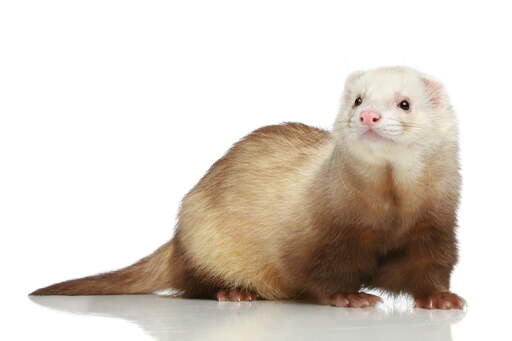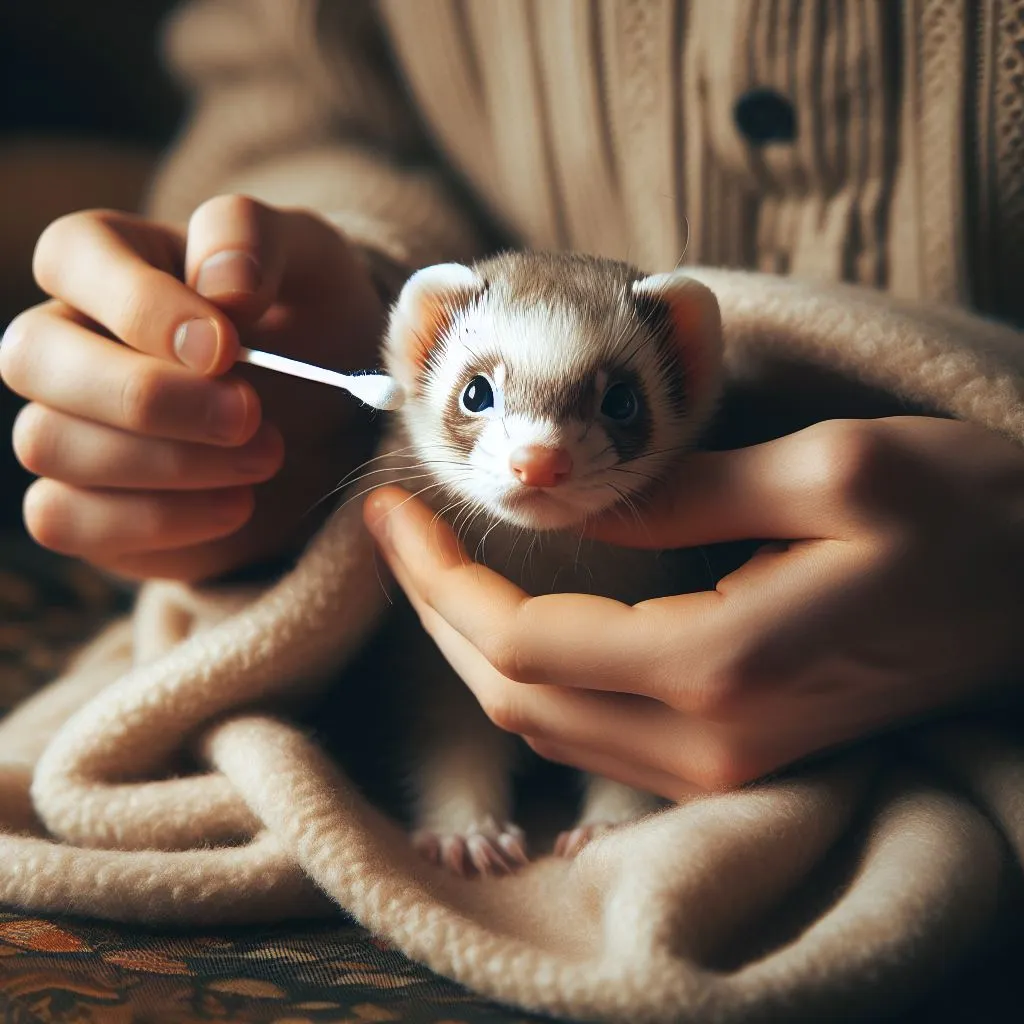Champagne Ferret | Overview With Care Guidelines

Unveil the world of the champagne ferret, a captivating polecat known for its pink noses and brown fur tips. Dive into this blog post to discover intriguing facts about the polecat, habitat details, and conservation efforts surrounding these enchanting animals.
Delve deeper into the realm of wildlife as we explore the importance of preserving biodiversity and understanding lesser-known species like the champagne ferret.
Appearance And Size

Champagne ferrets have a unique appearance with their diluted chocolate-like color and fur. Their fur coat consists of guard hairs, which are long and tan or beige, creating an outer layer, while the undercoat is white or cream, providing a soft contrast.
Champagne ferrets often have eyes in shades of dark ruby or standard brown, giving them a unique look. The pigmentation of their eyes sets them apart from albino ferrets. Their noses usually come in beige, pink, or pink with a beige/light brown ‘T’ outline.
Size and Weight Variation
These charming creatures usually measure between 15 to 20 inches (38 to 51 cm) in length when considering their tail as well. In terms of weight, champagne ferrets generally weigh around 1.5 to 4.4 pounds (0.7 to 2 kg). It’s worth noting that male champagne ferrets tend to be larger than females.
What Are the Unique Traits Of Champagne Ferrets?
Coat Color Mutation
Champagne ferrets have a distinct genetic mutation that affects their pigmentation, giving them a unique champagne coat color. This mutation results in their fur having a lighter hue compared to other ferret variations. Their coats often exhibit shades of pink noses and burgundy undertones.
These charming creatures also boast light-colored eyes and a distinctive mask, which is another distinguishing feature of champagne ferrets. Their eyes tend to be brighter and more noticeable due to the contrast with their lighter fur color. The combination of the light coat and eye colors gives champagne ferrets an unmistakable appearance that sets them apart from other ferret breeds.
Temperament Differences
Aside from their striking physical attributes, champagne ferrets may display slight variations in temperament compared to other colored ferrets. While individual personalities can vary widely among all ferret breeds, some owners believe that champagne ferrets exhibit unique behavioral traits such as being more laid-back or playful than their counterparts.
Temperament and Social Behavior
Playful Nature
Champagne ferrets are known for being playful and curious creatures. They enjoy engaging in interactive play sessions with their owners, which can include games like hide-and-seek or chasing toys. This playful behavior is a crucial aspect of their temperament that makes them delightful pets to have around the house.
Champagne ferrets have a keen sense of curiosity, often exploring their surroundings with their nose leading the way. Providing them with various toys and activities not only keeps them entertained but also helps stimulate their minds. These furry friends thrive on mental stimulation, making it essential for owners to engage them in activities that challenge their intellect.
Socialization Importance
Proper socialization from an early age is vital for champagne ferrets to develop good behavior and adapt well to different environments. Introducing them to various people, animals, and experiences helps build their confidence and ensures they grow up as well-adjusted pets. Fostering positive interactions during the critical developmental stages sets the foundation for a friendly and sociable champagne ferret.
Points to Consider Before Adoption
Time Commitment
Owning a champagne ferret entails a substantial time commitment for care and socialization. These playful creatures thrive on interaction and need daily attention.
- Ferrets, like champagne ferrets, require regular playtime and mental stimulation.
- Spending time with your pet helps build a strong bond and prevents boredom.
Properly caring for a champagne ferret involves financial responsibilities such as veterinary expenses and providing nutritious food. Ensuring their well-being requires budgeting for potential health issues that may arise over the years.
- Regular vet check-ups are essential to keep your champagne ferret healthy.
- Investing in high-quality food contributes to their overall health and longevity.
Legal Considerations
Before bringing home a champagne ferret, it’s crucial to research the local laws governing ferret ownership in your area. Some regions have specific regulations regarding exotic pets like ferrets.
- Familiarize yourself with any permits or licenses required for owning a champagne ferret.
- Understanding local laws can prevent legal issues down the road, ensuring a smooth adoption process.
Cost and Availability
Pricing Factors
Champagne ferrets, like other less common color variations, can be more expensive. Prices typically range from 100 to 500 USD. The cost may vary based on the reputation of the breeder and the lineage of the ferret.
Finding a reputable breeder is crucial when considering a champagne ferret due to their higher prices. Breeder reputation plays a significant role in determining the final cost of these unique pets. Lineage influences pricing; champion bloodlines often come with a higher price tag.
Adoption Options
Considering adoption from rescue organizations is an alternative for those interested in champagne ferrets but deterred by high prices. Rescue organizations offer these unique pets at more affordable rates compared to purchasing from breeders directly. Opting for adoption not only helps save money but also provides a loving home for a ferret in need.
What Are the Care and Habitat Essentials for Champagne Ferrets?
When owning a champagne ferret the owner must be aware of the things that are essential for their care and habitat. These can include things such as a proper ferret cage, toys, bedding, litter box, and grooming
What Are the Dietary Requirements Of A Champagne Ferret?
Just like any other ferret champagne ferret requires a diet that is rich in protein, fats and low in fiber and carbohydrates.
What Are the Nutritional Needs of Champagne Ferrets?
- Ferrets require high-quality animal protein (30-40%), essential fat (15-25%), and low fiber (<3%) in their diet.
- Offer specialized commercial ferret food or carefully formulated homemade diets to meet these requirements.
- Commercial foods simplify nutrition but may contain fillers, while homemade diets offer control but require attention to detail.
What Should A Champagne Ferret Eat?
- Ferrets require nutrients found only in animal tissue, so their diet should consist mainly of animal proteins like chicken, eggs, fish, tuna and other meats.
- Mimic their natural diet by offering whole prey items such as rabbits, rodents, and game birds for optimal nutrition.
What Should A Champagne Ferrets Avoid Eating?
- Avoid feeding ferrets fruits, vegetables, and other non-animal-based foods as their bodies are not adapted to digest them.
- Certain foods like onions, chocolate, and dairy can be toxic to ferrets and should be avoided to maintain their health.
What Are the Commercial Treats For Champagne Ferret?
- Animal-Based Ingredients: Choose treats with mainly animal-based ingredients, avoiding high-starch or plant-based proteins that may upset their digestive system.
- Avoid Harmful Components: Steer clear of treats containing ingredients like peanut butter, corn, or soybean meal, which may not align with ferrets’ dietary needs.
- Prioritize Nutrition: Focus on meeting ferrets’ specific dietary requirements of high protein, moderate fat, and low fiber, rather than following trends in pet nutrition.
Considerations for a Champagne Ferret Cage:
- Size and Dimensions: Ensure ample space, with dimensions like 24″ x 24″ x 18″ high. Multi-level cages are ideal for multiple ferrets.
- Ventilation: Opt for wire cages to maintain proper airflow and prevent breathing issues.
- Easy Cleaning: Look for replaceable panels and a large door for convenient cleaning.
- Safety: Ferret-proof the cage to prevent hazards like trapped limbs and avoid painted metal bars.
- Secure Lock: Prevent escapes with a reliable locking mechanism.
- Cage Construction: Choose quality materials like acrylic and metal for durability.
- Optional Wheels: Consider adding wheels for easy mobility.
Essential Cage Contents
- Toys: Provide entertainment with items like tunnels and balls.
- Bedding: Ensure comfort with hammocks and blankets.
- Litter Box: Train your ferret to use a suitable litter box with high sides and a low entrance.
Cleaning the Cage
- Use ferret-friendly cleaning products and essential tools like brushes and disinfectants.
- Maintain a daily, weekly, and annual cleaning schedule to ensure a hygienic environment.
- Reduce odor with air purifiers and regular litter box maintenance.
- Opt for appropriate litter and consider having a box per ferret for cleanliness.
How To Groom A Champagne Ferret?
Grooming a champagne ferret is very essential if you are deciding to own one. Proper grooming ensures that you will keep your ferret healthy, clean and even increase their lifespan.
What Are The Things Required To Groom A Champagne Ferret?
- Brushing Fur: Regular brushing removes loose hair, prevents hairballs, and maintains coat health.
- Nail Trimming: Prevent scratching and discomfort by trimming nails weekly.
- Ear Cleaning: Clean ears monthly to prevent infections and wax buildup.
- Bathing: Bathe sparingly to reduce odor and maintain cleanliness, using ferret-specific shampoo.
How To Do Nail Care For Champagne Ferret?
- Clip nails weekly using small animal or human nail clippers.
- Identify the clear part of the nail to avoid cutting into the blood vessel.
- Distract your ferret with treats during trimming and seek assistance if needed.
How To Do Dental Care For Champagne Ferret?
- Use pet-specific toothbrush and toothpaste to brush teeth regularly.
- Offer soft foods over crunchy kibbles to reduce dental damage.
- Introduce toothpaste gradually and increase brushing session time slowly.
How To Do Ear Cleaning For Champagne Ferret?
- Clean ears monthly using ferret-specific ear cleaning solution and cotton swabs.
- Be gentle and monitor for signs of discomfort or infection.
How To Bathe A Champagne Ferret?
- Bathe monthly using ferret shampoo in shallow water.
- Avoid overbathing to maintain natural oils in the fur.
- Dry with a towel and use conditioner if needed for soft, shiny fur.
What Is The Importance Of Regular Grooming For Ferrets?
- Prevents health issues such as matting, overgrown nails, dental diseases, and ear infections.
- Brush fur weekly, trim nails regularly, clean ears monthly, and bathe sparingly.
- Be patient and gentle, observing your ferret’s behavior for signs of distress.
Overview of Ferret Colors and Patterns
Variety of Colors and Patterns
Ferrets display a range of colors and patterns, with the champagne ferret standing out for its unique hue. Their appearance is dictated by genetics, resulting in coats that can be solid or patterned. For example, a champagne ferret boasts a distinctive pale beige coat complemented by pinkish or light brown noses.
Champagne ferrets are known for their striking coloration characterized by a pale beige shade with pinkish or light brown noses. This specific coloring sets them apart from other common colors like dark silver, chocolate brown, and white undercoat variations found in ferrets. The brown fur tips on their coat give them an elegant look that many find appealing.
Understanding Ferret Markings and Patterns
Different Ferret Markings
Ferrets can have various markings such as solid, roan, panda, mitts, blaze, and sable patterns. These markings are like unique color combinations on their fur that help distinguish one ferret from another. For example, a panda pattern has distinct white patches around the eyes and sometimes on the body.
Solid coat colors are common in some ferrets like champagne ferrets, where there are no noticeable chest markings or other patterns. This makes them stand out among other breeds with more intricate designs on their fur. By recognizing these different patterns, owners can identify specific breeds or genetic traits present in their ferrets based on their appearance.
Identifying Breeds and Traits
Understanding these diverse undercoat colors and guard hairs is essential for identifying particular breeds of ferrets accurately. For instance, if a ferret displays a blaze pattern with a distinctive stripe down its head to its tail, it indicates a specific breed trait. Recognizing these unique characteristics helps owners understand more about their pet’s lineage and potential health concerns associated with certain genetic traits.
Compatibility with Other Pets
Introducing Champagne Ferrets to Other Pets
When introducing champagne ferrets to other pets, it’s crucial to do so gradually and under supervision. Slowly allowing them to interact can help prevent any potential conflicts that may arise. For instance, if a champagne ferret is introduced too quickly to another pet, such as a cat or dog, it could lead to stress and aggression.
It’s advisable for owners to consider the temperament and behavior of both the champagne ferret and the other pets before introducing them. Each animal has its own unique personality traits that should be taken into account. By understanding how each pet behaves, owners can better predict how they will react when brought together. This knowledge can help prevent any negative interactions between the animals.
Benefits of Supervised Interactions
- Prevents potential conflicts.
- Allows gradual introduction.
- Helps gauge reactions of all pets involved.
- Reduces stress for all animals.
Summary
The characteristics and care requirements of Champagne Ferrets have been thoroughly explored in the preceding sections, shedding light on their unique traits, social behavior, and compatibility with other pets. Understanding their appearance, temperament, and habitat essentials is crucial for anyone considering adopting these fascinating creatures.
With insights into ferret colors, markings, and patterns, potential owners can make informed decisions before welcoming a Champagne Ferret into their homes. Moreover, the cost and availability factors provide a comprehensive overview for those interested in adding these delightful animals to their families.
For those intrigued by the charm of Champagne Ferrets, delving deeper into their world can be an enriching experience. Whether seeking a new furry companion or expanding knowledge about exotic pets, exploring the realm of Champagne Ferrets offers a rewarding journey into the realm of unique animal companionship.
Frequently Asked Questions
Champagne ferrets have a distinctive coat color that ranges from cream to light brown with red eyes. They possess an energetic and playful nature, making them delightful companions for interactive playtime.
Prospective owners should ensure they have adequate space for the ferret to roam and play. Research their dietary needs, invest in proper housing and toys, and establish a relationship with a veterinarian experienced in treating ferrets.
Champagne ferrets need a balanced diet rich in protein, regular grooming to maintain their coat health, sufficient exercise opportunities outside of their cage daily, routine vet check-ups, and mental stimulation through interactive toys or games.
With proper introductions and supervision, Champagne Ferrets can live harmoniously with other pets such as dogs or cats. It’s crucial to monitor initial interactions closely to ensure all animals feel safe and comfortable in each other’s presence.
Potential adopters can contact local animal shelters specializing in small animals or search online platforms dedicated to rehoming pets. Reaching out to reputable breeders who prioritize ethical practices is another option when looking for Champagne Ferret availability.
Last Updated on 28 February 2024
Waman Nuka is a seasoned wordsmith and a passionate animal enthusiast with decades of experience in the world of animal care. With a deep love for all creatures great and small, Waman’s journey in the realm of animals started as a young boy exploring the lush forests surrounding his childhood home.


